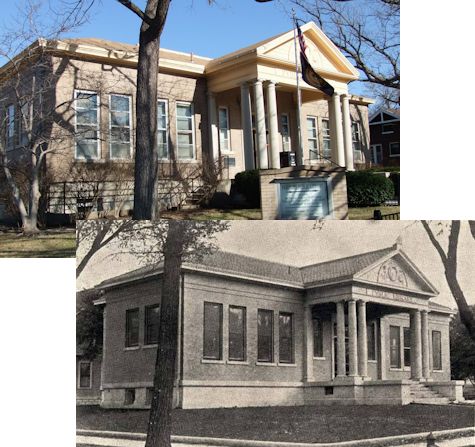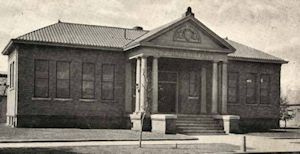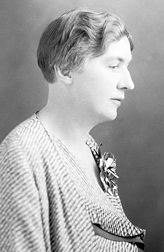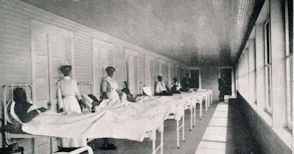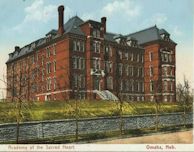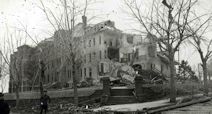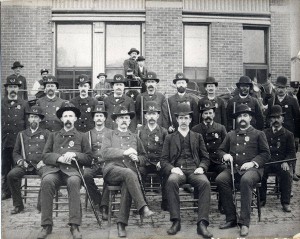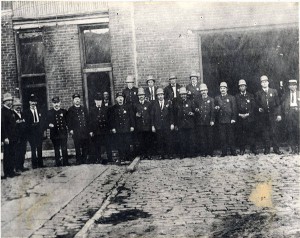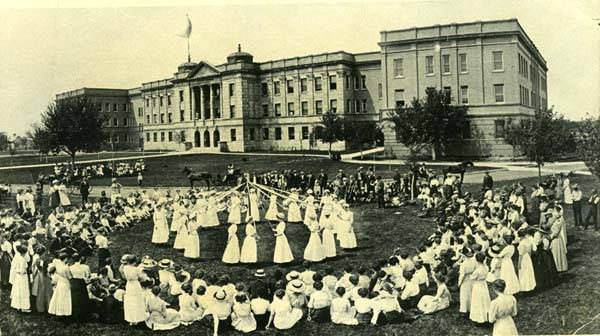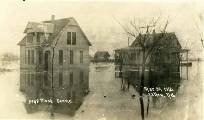Search the Blog
Categories
- Books & Reading
- Broadband Buzz
- Census
- Education & Training
- General
- Grants
- Information Resources
- Library Management
- Nebraska Center for the Book
- Nebraska Libraries on the Web
- Nebraska Memories
- Now hiring @ your library
- Preservation
- Pretty Sweet Tech
- Programming
- Public Library Boards of Trustees
- Public Relations
- Talking Book & Braille Service (TBBS)
- Technology
- Uncategorized
- What's Up Doc / Govdocs
- Youth Services
Archives
Subscribe
Category Archives: Nebraska Memories
Take Me Out to the Ball Game
The crack of the bat on a ball, the smack of a ball hitting a mitt, and the umpire’s cry of “You’re out!” Ah, the sounds of summer. America’s most popular pastime hit a home run in early Nebraska–be it high school, college, league or pick-up at the sandlot, boys and men enjoyed a game of baseball.
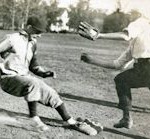 In this Union College game from 1911-1912, the player sliding into base wears a uniform, while the player stretching a mitt to catch the ball looks to be wearing street clothes. Other college photos in Nebraska Memories show the teams lined up in uniform, sometimes with coaches and ball boys. Towns, big and small, also had their teams and fans showed up to the games.
In this Union College game from 1911-1912, the player sliding into base wears a uniform, while the player stretching a mitt to catch the ball looks to be wearing street clothes. Other college photos in Nebraska Memories show the teams lined up in uniform, sometimes with coaches and ball boys. Towns, big and small, also had their teams and fans showed up to the games.
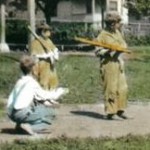 Younger boys may have played in a league or, as in this picture, in a pick-up game on a lot or playground. These boys don’t seem to have had a home plate or bags for the bases, but there seem to be plenty of bats and mitts as the pitcher winds up for a pitch. And there wouldn’t have been a problem of spiking, as more than one of the boys appears to be barefoot.
Younger boys may have played in a league or, as in this picture, in a pick-up game on a lot or playground. These boys don’t seem to have had a home plate or bags for the bases, but there seem to be plenty of bats and mitts as the pitcher winds up for a pitch. And there wouldn’t have been a problem of spiking, as more than one of the boys appears to be barefoot.
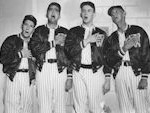 Baseball even made an appearance on-stage at the Omaha Community Playhouse with a production of Damn Yankees. These unnamed Omaha crooners may or may not have played baseball at some time in real life, but I’m sure they were crowd pleasers.
Baseball even made an appearance on-stage at the Omaha Community Playhouse with a production of Damn Yankees. These unnamed Omaha crooners may or may not have played baseball at some time in real life, but I’m sure they were crowd pleasers.
Visit Nebraska Memories to search for or browse through many more historical images digitized from photographs, negatives, postcards, maps, lantern slides, books and other materials.
Nebraska Memories is a cooperative project to digitize Nebraska-related historical and cultural heritage materials and make them available to researchers of all ages via the Internet. Nebraska Memories is brought to you by the Nebraska Library Commission. If your institution is interested in participating in Nebraska Memories, see http://nlc.nebraska.gov/nebraskamemories/participation.aspx for more information, or contact Beth Goble, Historical Projects Librarian, or Devra Dragos, Technology & Access Services Director.
Posted in Nebraska Memories
Leave a comment
Busting sod
This week marks the 151st anniversary of the passage of the Homestead Act on May 20, 1862. Homesteaders were allotted 160 acres of land. They had to live on their land and make improvements within six months, including building a home. After 5 years on the land, the original filer was entitled to the property after paying a small registration fee. On January 1, 1863, Daniel Freeman met some local Land Office officials and convinced a clerk to open the office shortly after midnight in order to file a land claim. Freeman became one of the first to file a claim. 160 acres proved to be too small for the arid parts of Nebraska. The Kinkaid Act of 1904, authored by Nebraska Congressman Moses P. Kinkaid, increased the allotment to 640 acres in western and central portions of Nebraska, primarily in the Sandhills.
Trees were in short supply , and the tough sod
being “busted” for crop production became 
building blocks for homes, barns, and even schools.
Several Nebraska Memories participants have
contributed photos depicting homesteaders.
The house in this photo of the Mundshaw’s Sod House from the Cheyenne County Historical Society collection looks quite substantial, with a durable roof and glass windows. It probably had a wood floor as well. 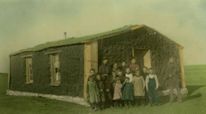 Cheyenne county also boasted a Sod School in District #68 . It actually had a stone foundation. Eight of the children in this 1904-05 picture are named Olsen, with photographer Otto Olsen using a string to snap the photo so that he could be in it.
Cheyenne county also boasted a Sod School in District #68 . It actually had a stone foundation. Eight of the children in this 1904-05 picture are named Olsen, with photographer Otto Olsen using a string to snap the photo so that he could be in it.
Other parts of Nebraska had trees for lumber. 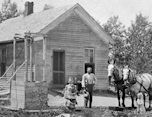
Mr. and Mrs. James Cornell and their children
stand in front of a wood frame house in Butler County
in this photograph from the Boston Studio Project
collection, taken in the late 1890s.
 There was no Kingsley Dam or Tri-County irrigation canal holding and diverting water from the Platte River into parched fields in Phelps County in those early days. It’s hard to imagine how the family in the 1880’s photo of their Dry land farm, Phelps County, Nebraska survived. The rows of corn look dried up. Perhaps the windmill behind the house provided enough water for the crop.
There was no Kingsley Dam or Tri-County irrigation canal holding and diverting water from the Platte River into parched fields in Phelps County in those early days. It’s hard to imagine how the family in the 1880’s photo of their Dry land farm, Phelps County, Nebraska survived. The rows of corn look dried up. Perhaps the windmill behind the house provided enough water for the crop.
Visit Nebraska Memories to search for or browse through many more historical images digitized from photographs, negatives, postcards, maps, lantern slides, books and other materials.
Nebraska Memories is a cooperative project to digitize Nebraska-related historical and cultural heritage materials and make them available to researchers of all ages via the Internet. Nebraska Memories is brought to you by the Nebraska Library Commission. If your institution is interested in participating in Nebraska Memories, see http://nlc.nebraska.gov/nebraskamemories/participation.aspx for more information, or contact Beth Goble, Historical Services Librarian, or Devra Dragos, Technology & Access Services Director.
Posted in General, Information Resources, Nebraska Memories
Leave a comment
Celebrate National Nurses Week
National Nurses Week is celebrated every year from May 6, which is National Nurses Day, to May 12, which is the birthday of Florence Nightingale. After taking a moment to thank the nurses that you know, explore these images of nurses in Nebraska Memories.
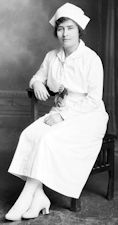 For a look at nursing uniforms of the past, check out these portraits of Emily Anderson, taken in 1920, and this unknown nurse, taken in the late 1890s or early 1900s. Their outfits are a far cry from the scrubs and comfortable shoes worn by nurses today.
For a look at nursing uniforms of the past, check out these portraits of Emily Anderson, taken in 1920, and this unknown nurse, taken in the late 1890s or early 1900s. Their outfits are a far cry from the scrubs and comfortable shoes worn by nurses today.
Many of the images of nurses in Nebraska Memories are part of the 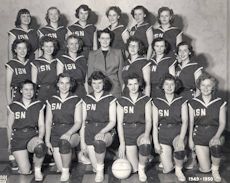 Alegent Health Immanuel Medical Center collection. They depict many different aspects of life for students at the Immanuel Deaconess Institute School of Nursing. Images in this collection include a posed shot of a group of freshman students, a team photo of the School of Nursing’s women’s basketball team and a view of a capping ceremony, in which students
Alegent Health Immanuel Medical Center collection. They depict many different aspects of life for students at the Immanuel Deaconess Institute School of Nursing. Images in this collection include a posed shot of a group of freshman students, a team photo of the School of Nursing’s women’s basketball team and a view of a capping ceremony, in which students 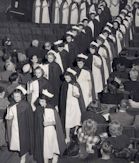 received their nursing caps after their first year probation.
received their nursing caps after their first year probation.
Visit Nebraska Memories to search for or browse through many more historical images digitized from photographs, negatives, postcards, maps, lantern slides, books and other materials.
Nebraska Memories is a cooperative project to digitize Nebraska-related historical and cultural heritage materials and make them available to researchers of all ages via the Internet. Nebraska Memories is brought to you by the Nebraska Library Commission. If your institution is interested in participating in Nebraska Memories, see http://nlc.nebraska.gov/nebraskamemories/participation.aspx for more information, or contact Beth Goble, Historical Services Librarian, or Devra Dragos, Technology & Access Services Director.
Posted in General, Information Resources, Nebraska Memories
Leave a comment
Three Carnegie Libraries
As National Library Week comes to an end I wanted to highlight a few of the sixty plus Carnegie libraries that were built across Nebraska. When talking about Carnegie libraries I’m referring to those libraries built with the help of Andrew Carnegie. According to information on the Library of Congress’s website Carnegie helped to build over 2,500 libraries worldwide. You may also recognize his name in connection with the Carnegie Hall and Carnegie Mellon University.
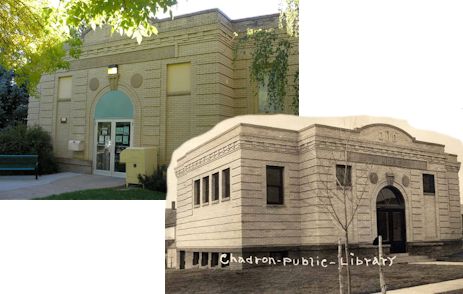
- Chadron Public Library
The first building I want to highlight is the Chadron Public Library. The bulding is located at 507 Bordeaux St in Chadron as is still the current home of the Chadron Public Library. The building was designed by George Berlinghof of Lincoln who received $100 for the architectural plans. The building was completed in 1911. Comparing the photo of the library in Nebraska Memories taken sometime in the 1920’s to a more recent photo taken in 2006 you can see the front of the building is relatively unchanged. The most noticeable change is the removal of the decorative windows. According to the National Register of Historic Places Registration Form these windows were removed in 1964 as part of effort to make the building more energy efficient.
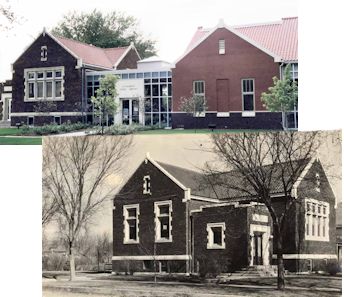
- Gothenburg Public Library
Let’s head a bit southeast and look at the Gothenburg Public Library. The library is located at 1104 Lake Ave in Gothenburg. This Carnegie library was completed in 1916. Comparing the recent photo and the historical photo you can see that an addition was added that mimics the lines of the original building.
For our last stop let’s look at the Fairbury Public Library. The library is located at the corner of 7th and F Street. Carnegie donated $12,500 for the library which was built on a lot purchased by the city for $2,500. The building was designed by Tyler and Son of Lincoln. It opened to the public in December of 1909 and is still being used today.
As I was researching the Fairbury Carnegie building I found an article in the 1908 North Platte semi-weekly tribune that mentioned that the town of Fairbury was asking Mr. Carnegie for additional funds. The article also stated: “They Library will be practically a duplicate of the one at Kearney.”
Comparing the historical images of the Fairbury Public Library and the Kearney Public Library I was surprised to see how similar they looked on the outside. Unfortunately we can’t compare current photos of the Carnegie buildings because the building in Kearney was torn down in 1975. We can however see what the Adult Reading Room and the Children’s Room looked like in the Kearney Carnegie building in the 1920’s.
Visit Nebraska Memories to search for or browse through many more historical images digitized from photographs, negatives, postcards, maps, lantern slides, books and other materials.
Nebraska Memories is a cooperative project to digitize Nebraska-related historical and cultural heritage materials and make them available to researchers of all ages via the Internet. Nebraska Memories is brought to you by the Nebraska Library Commission. If your institution is interested in participating in Nebraska Memories, see http://nlc.nebraska.gov/nebraskamemories/participation.aspx for more information, or contact Beth Goble, Historical Projects Librarian, or Devra Dragos, Technology & Access Services Director.
Posted in General, Information Resources, Nebraska Memories
Leave a comment
Where do writers get their ideas?
A common answer to this question may be: anywhere and everywhere. So what can they do if they hit a writer’s block or don’t know how to describe something historical? Our suggestion is–try Nebraska Memories!
The photograph and description of Dr. Muriel Anderson, a blind osteopath who practiced in David City, Nebraska, from 1924 to 1971 can generate many questions and ideas. What would it be like to be a blind doctor? How would your other senses take over when you couldn’t see a patient? What kind of challenges did she face in her medical education in the early 1920s–as a woman, as well as being blind? What other challenging occupations did women with disabilities become successful in during that time? What would it be like to be a patient of a blind doctor? What would happen if a patient tried to pull a fast one on the doctor? What if … ? Now you fill in the blank.
A writer may have an idea but might not be sure how to describe the scene. Say your heroine is working in a state institution caring for patients with tuberculosis, what would the patient housing be like? What type of buildings were at a state institution? What type of people were cared for at state institutions? What was life like at a state institution? What did rooms look like in homes, schools, stores, manufacturing plants, and other buildings?
A writer might wonder: what did people wear when they were working? What did they wear to have a studio portrait taken? What did they do for fun? What did small western towns look like? What did bigger towns look like? What kind of pets did they have? Find images and stories about all of these at Nebraska Memories.
Nebraska Memories is a cooperative project to digitize Nebraska-related historical and cultural heritage materials and make them available to researchers of all ages via the Internet. Nebraska Memories is brought to you by the Nebraska Library Commission. If your institution is interested in participating in Nebraska Memories, see http://nlc.nebraska.gov/nebraskamemories/participation.aspx for more information, or contact Beth Goble, Historical Projects Librarian, or Devra Dragos, Technology & Access Services Director.
Posted in Nebraska Memories
Leave a comment
100 years ago this month: The Omaha Easter Tornado of 1913
They called it the Devil Cloud. At about 6:00 pm on March 23, 1913 the “Easter Sunday Tornado” struck Omaha and cut a swath from 49th & Poppleton Sts. through Carter Lake to Council Bluffs Iowa. 140 citizens were killed and 400 injured. News of Omaha’s disaster went out on the only surviving telegraph wire — the Omaha Daily News. It remains one of Omaha’s greatest distasters, killing at least 150 people and injuring many more. This account from the March 25th 1913 EXTRA editon of the Omaha Daily Bee shows a map of the storm’s path.
The Idlewild Club at 2307 North 24th Street was the scene 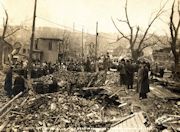 of the greatest loss of life. The owner, C. W. Dillard, and 13 customers were killed as they tried to take shelter on the south side of the pool hall’s basement. The victims were crushed by falling debris or overcome by smoke from fires begun when woodstoves used for heating overturned. The postcard image shows the slow process of removing the debris to recover the bodies. The victims were then removed to the Webster Telephone Exchange Building at 2213 Lake Street.
of the greatest loss of life. The owner, C. W. Dillard, and 13 customers were killed as they tried to take shelter on the south side of the pool hall’s basement. The victims were crushed by falling debris or overcome by smoke from fires begun when woodstoves used for heating overturned. The postcard image shows the slow process of removing the debris to recover the bodies. The victims were then removed to the Webster Telephone Exchange Building at 2213 Lake Street.
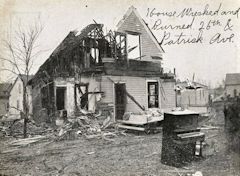 This image of a house wrecked and burned at 26th & Patrick Avenue in northeast Omaha illustrates the danger. Fire was breaking out along the corridor of destruction. Entire police and fire departments from Omaha and Council Bluffs, Iowa, were called to the scene. They fought the fires along Franklin and Decatur streets 3 blocks south of Patrick Avenue for nearly an hour. Firemen carried hoses because trucks could not reach the flames. Heavy rain fell after 8 p.m. and by 9 p.m. the houses were smoldering ruins. The piano sitting out front may be the only thing that was saved.
This image of a house wrecked and burned at 26th & Patrick Avenue in northeast Omaha illustrates the danger. Fire was breaking out along the corridor of destruction. Entire police and fire departments from Omaha and Council Bluffs, Iowa, were called to the scene. They fought the fires along Franklin and Decatur streets 3 blocks south of Patrick Avenue for nearly an hour. Firemen carried hoses because trucks could not reach the flames. Heavy rain fell after 8 p.m. and by 9 p.m. the houses were smoldering ruins. The piano sitting out front may be the only thing that was saved.
The Sacred Heart Convent immediately to the south of Bemis Park suffered heavy damage. The color postcard of the Academy of the Sacred Heart shows what it looked like before the storm. The photograph on the right of the Sacred Heart Academy shows the damage to the side facing Bemis Park.
Many more tornado images documenting the destruction the tornado caused are in the Omaha Public Library collection in Nebraska Memories . The 100th anniversary of the Easter Tornado will be featured in an NET television progam called Devil Clouds: Tornadoes Strike Nebraska to be broadcast March 22nd.
Visit Nebraska Memories to search for or browse through many more historical images digitized from photographs, negatives, postcards, maps, lantern slides, books and other materials.
Nebraska Memories is a cooperative project to digitize Nebraska-related historical and cultural heritage materials and make them available to researchers of all ages via the Internet. Nebraska Memories is brought to you by the Nebraska Library Commission. If your institution is interested in participating in Nebraska Memories, see http://nlc.nebraska.gov/nebraskamemories/participation.aspx for more information, or contact Beth Goble, Historical Services Librarian, or Devra Dragos, Technology & Access Services Director.
Posted in General, Information Resources, Nebraska Memories
1 Comment
On the Beat
Police officers have been a part of Nebraska’s communities for a long time. Take a look at 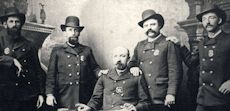 Nebraska Memories to see some images of Nebraska’s police forces through the years. The uniforms worn by Lincoln’s officer in 1885 or 1920 are certainly a far cry from what we are familiar with today. Even in the
Nebraska Memories to see some images of Nebraska’s police forces through the years. The uniforms worn by Lincoln’s officer in 1885 or 1920 are certainly a far cry from what we are familiar with today. Even in the  1940s, this Omaha officer’s outfit looked fairly different from modern uniforms.
1940s, this Omaha officer’s outfit looked fairly different from modern uniforms.
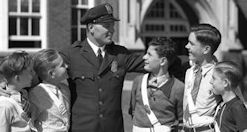 If you are interested in more than just fashion, for a slice of history pertaining to the Lincoln Police Department, check out the department’s annual reports from the 1940s, 1950s, and 1960s. These reports contain a wealth of information, including the number of personnel (and their monthly salaries), information about the duties of the various division and bureaus of the department, and information about the number of arrests made (and for what offenses), among other facts.
If you are interested in more than just fashion, for a slice of history pertaining to the Lincoln Police Department, check out the department’s annual reports from the 1940s, 1950s, and 1960s. These reports contain a wealth of information, including the number of personnel (and their monthly salaries), information about the duties of the various division and bureaus of the department, and information about the number of arrests made (and for what offenses), among other facts.
Visit Nebraska Memories to search for or browse through many more historical images digitized from photographs, negatives, postcards, maps, lantern slides, books and other materials.
Nebraska Memories is a cooperative project to digitize Nebraska-related historical and cultural heritage materials and make them available to researchers of all ages via the Internet. Nebraska Memories is brought to you by the Nebraska Library Commission. If your institution is interested in participating in Nebraska Memories, see http://nlc.nebraska.gov/nebraskamemories/participation.aspx for more information, or contact Beth Goble, Historical Services Librarian, or Devra Dragos, Technology & Access Services Director.
Posted in Nebraska Memories
Leave a comment
A Nebraska Connection…to Black History Month
To commemorate and celebrate the contributions to our nation made by people of African descent, American historian Carter G. Woodson established Black History Week. The first celebration occurred on Feb. 12, 1926. For many years, the second week of February was set aside for this celebration to coincide with the birthdays of abolitionist/editor Frederick Douglass and Abraham Lincoln. In 1976, as part of the nation’s bicentennial, the week was expanded into Black History Month. Each year, U.S. presidents proclaim February as National African-American History Month.
While remembering that February is Black History Month, and finding specific connections to Nebraska, I read an article this morning sent to me by Lori Sailors here at the Library Commission. The article is definitely connected to Nebraska. In particular: Lincoln, Nebraska. Hansen: Century-old photos of Lincoln African-Americans headed to Smithsonian is about a collection of photographs dating from 1910-1925 of Lincoln’s black community, taken by John Johnson, an African-American resident of Lincoln, and the son of an escaped slave. It’s a great article, with a few photographs featured at the beginning, and a link to more of the collection about mid-way down the page.
In following the Lincoln and Nebraska connection to Black History Month, Nebraska Memories also has a collection of African-American photographs. There are two that stand out as being Lincoln specific: the Lincoln Police Department in 1895 and 1907, both of which include J.C. Earley, the first African-American police officer in Lincoln.
To see more photographs of African-American Nebraskans, including children, musicians, boxers, and even two women with a turkey, please visit Nebraska Memories. No matter who or what you search for, you’ll be surprised by what you find, and learn, about Nebraska history!
Nebraska Memories is a cooperative project to digitize Nebraska-related historical and cultural heritage materials and make them available to researchers of all ages via the Internet. Nebraska Memories is brought to you by the Nebraska Library Commission. If your institution is interested in participating in Nebraska Memories, see Introduction to Participating in Nebraska Memories for more information, or contact Beth Goble, Historical Projects Librarian, or Devra Dragos, Technology & Access Services Director.
Posted in Nebraska Memories
Leave a comment
Blizzard Reunion
This weekend while reading the paper I ran across an article – “The Blizzard of 1888 — the force of a white hurricane — hit 125 years ago” – about the blizzard of January 12, 1888. The blizzard took many people by surprise because the day started out relatively warm before the storm moved in. The storm hit while many children were at school causing many students to be stranded at school or they struggled to get home during the storm. Because of these struggles the blizzard became known as the Children’s Blizzard. Across the Great Plains 235 people, including a number of children, perished in the storm.
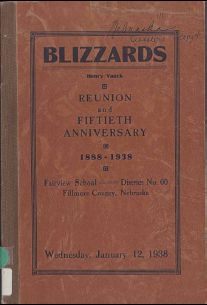 On January 12, 1938, fifty years after the blizzard, students of the Fairview School, in Fillmore County, Nebraska got together for a reunion. A record of the reunion can be found in the self-published book: Blizzards: reunion and fiftieth anniversary, 1888-1938. The complete text of this book is available in Nebraska Memories at: http://memories.ne.gov/u?/hpl,0
On January 12, 1938, fifty years after the blizzard, students of the Fairview School, in Fillmore County, Nebraska got together for a reunion. A record of the reunion can be found in the self-published book: Blizzards: reunion and fiftieth anniversary, 1888-1938. The complete text of this book is available in Nebraska Memories at: http://memories.ne.gov/u?/hpl,0
Part of the books contains what is described as “Letters and Life Sketches of Schoolmates”. These are letters written by the former students tell what they remember of the storm an update of what has happened in their lives over the past 50 years. Frank J. Stephenson was the teacher at the Fairview School in 1988. In one of his letters he wrote the following: “… the event of the blizzard I remember in detail. The warm pleasant snow falling to an unusual depth, then about 2 o’clock a noise outside as of rushing animals. A glance at the windows already darkening revealed the cause. Then one window began to give away before the pressure. You boys helped prop a bench against it to hold it in place. Then to overcome panic we had a “Chinese School,” everybody studying at the top of this voice. When we tired of this several of us went out and carried in a vast store of coal to last the night. Then two farmers drove their teams to the school house for most of the children, and I know I spent the night at August Stalldorf’s near the corner…. I recall that my sister tied her pupils together and led them to a nearby farm house.”
To read this book or learn more about Nebraska’s history visit Nebraska Memories and search for or browse through many more historical images digitized from photographs, negatives, postcards, maps, lantern slides, books and other materials.
Nebraska Memories is a cooperative project to digitize Nebraska-related historical and cultural heritage materials and make them available to researchers of all ages via the Internet. Nebraska Memories is brought to you by the Nebraska Library Commission. If your institution is interested in participating in Nebraska Memories, see http://nlc.nebraska.gov/nebraskamemories/participation.aspx for more information, or contact Beth Goble, Historical Projects Librarian, or Devra Dragos, Technology & Access Services Director.
Posted in Nebraska Memories
Leave a comment
“And when the votes are counted you will never know they ran”
“And when the votes are counted you will never know they ran”. At least that’s what James Asher Parks wrote back in 1908 in the campaign song “Holding Hands”. Here’s the complete second verse:
“Willie Hearst* and Billy Bryan* tried to play a little game, “Holding hands,” Parker too, and poor old Davis likewise tried to do the same, “Holding hands,” The candidates they’re running all are “three-spots” to a man, And when the votes are counted you will never know they ran, You will find them all a standing just about where they began, “Holding hands!””
 I think Mr. Parks might be correct. I knew who Willie Hearst and Billy Bryan were but I must admit I had no idea who Parker and Davis might be. After a quick search I believe he is referring to Alton B. Parker and Henry G. Davis. Alton Parker ran for president in 1904 and Henry G. Davis was his vice-president candidate. As you may know Parker lost that election to Theodore Roosevelt.
I think Mr. Parks might be correct. I knew who Willie Hearst and Billy Bryan were but I must admit I had no idea who Parker and Davis might be. After a quick search I believe he is referring to Alton B. Parker and Henry G. Davis. Alton Parker ran for president in 1904 and Henry G. Davis was his vice-president candidate. As you may know Parker lost that election to Theodore Roosevelt.
“Holding Hands” is just one of twenty-four songs that appear in “Park’s Republican campaign songs”. This book of scores was written by James Asher Parks who was a famous composer and publisher from York Nebraska. “Holding Hands” can be found on page 25. Many of the other scores in this book made me laugh and others made my cringe. I never realized how nasty politics were in 1904.
As you were reading the lyrics above you may have noticed the asterisks after Hearst’s and Bryan’s names. Asterisks like these appear throughout this book. The footnote that goes along with these asterisk states: “Use name of any Democrat desired.” Mr. Parks included an announcement at the front of the book letting folks know that because of the “early demand for Campaign music” these songs were written before the presidential candidates were officially announced. He went on to say that any candidates name could be substituted and “As a rule, any name of two syllables will serve the purpose.” He also stated that folks should “Commit the words and music to memory before rendering and sing with VIM and VIGOR.”
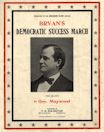 The song “Holding Hands” was clearly a song for the opponents of William Bryan to sing. To be fair I also wanted to point out two scores that support William Bryan. The first one is “Bryan’s Democratic success march” written by George Maywood (also known as George Schleiffarth). Unfortunately there’s not much to say about this score since it has no lyrics. The other song written in support of Bryan is called “Line up for Bryan”. It was written by Nebraska Lawyer and politician George W. Gale. This song does include lyrics.
The song “Holding Hands” was clearly a song for the opponents of William Bryan to sing. To be fair I also wanted to point out two scores that support William Bryan. The first one is “Bryan’s Democratic success march” written by George Maywood (also known as George Schleiffarth). Unfortunately there’s not much to say about this score since it has no lyrics. The other song written in support of Bryan is called “Line up for Bryan”. It was written by Nebraska Lawyer and politician George W. Gale. This song does include lyrics.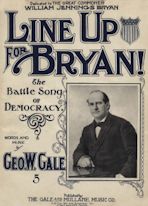
“We are marching on to victory There’s music in the air, We’ll place our gallant leader in the presidential chair We are ready for the battle now we’re waiting for the day We’ll fall in line for Bryan boys Hip Hip Hooray.”
I hope you enjoyed this break from modern day politics and were amused by politics of the past. Do you think after the votes are counted and a hundred or so years pass that folks will remember who ran and lost today’s election?
Visit Nebraska Memories to search for or browse through many more historical images digitized from photographs, negatives, postcards, maps, lantern slides, books and other materials.
Nebraska Memories is a cooperative project to digitize Nebraska-related historical and cultural heritage materials and make them available to researchers of all ages via the Internet. Nebraska Memories is brought to you by the Nebraska Library Commission. If your institution is interested in participating in Nebraska Memories, see http://nlc.nebraska.gov/nebraskamemories/participation.aspx for more information, or contact Beth Goble, Historical Projects Librarian, or Devra Dragos, Technology & Access Services Director.
Subject Headings: The Original Tags
If you’ve spent any time browsing the collections in Nebraska Memories, you have probably noticed that each item has a list of terms next to the word Subject. These are called subject headings, which is librarian-speak for words that tell you what a particular item is about. They are similar to tags that you might use to describe things on social networking sites, like pictures on Flickr. The difference is that while you can use whatever tags you want, subject headings are chosen from a specific list of words.
Why do we add subject headings to the Nebraska Memories records, and how can they help you search? For one thing, they bring together all of the items that have the same subject heading, so that you can find pictures of the same things. This is especially important in cases where different words might be used to describe the same thing. For  example, the title of this photograph uses the word “automobile”, while the title of this photograph uses the word “car”. However, both of them have the same subject heading – “Automobiles.” Now that
example, the title of this photograph uses the word “automobile”, while the title of this photograph uses the word “car”. However, both of them have the same subject heading – “Automobiles.” Now that  you know this, you can click on that subject headings to find all of the items relating to cars in that particular collection. if you want to find all of the images of cars in all the Nebraska Memories collections, you can go to the search page and type Automobiles in the subject field. This will help you find all the items in Nebraska Memories that show pictures of cars, or relate to cars in some way. If you know what word was used to describe them, you can be sure that you are not missing out on any car-related items.
you know this, you can click on that subject headings to find all of the items relating to cars in that particular collection. if you want to find all of the images of cars in all the Nebraska Memories collections, you can go to the search page and type Automobiles in the subject field. This will help you find all the items in Nebraska Memories that show pictures of cars, or relate to cars in some way. If you know what word was used to describe them, you can be sure that you are not missing out on any car-related items.
There’s another added bonus to subject headings; they can help you narrow your search when the same word is used to mean two different things. For example, if you happened upon this photograph of William Jennings Bryan in a room used as a library, you might decide that you want to look for other rooms used as libraries. If you go to the search page and search for “Libraries” in the subject field, you will get a lot of results, including library buildings and bookmobiles, in addition to the rooms used as libraries you were looking for. If you look closely at your original picture, you will see that it was assigned the subject heading “Libraries (Rooms & spaces).” This differentiates it from items with the subject heading “Libraries”, which is used for whole buildings that function as libraries. Doing a subject search for Libraries (Rooms & spaces) brings up a much more manageable list of results, targeted to the exact thing you’re looking for.
buildings and bookmobiles, in addition to the rooms used as libraries you were looking for. If you look closely at your original picture, you will see that it was assigned the subject heading “Libraries (Rooms & spaces).” This differentiates it from items with the subject heading “Libraries”, which is used for whole buildings that function as libraries. Doing a subject search for Libraries (Rooms & spaces) brings up a much more manageable list of results, targeted to the exact thing you’re looking for.
The next time you are looking at Nebraska Memories, remember subject headings and how they can take your search to the next level.
Visit Nebraska Memories to search for or browse through many more historical images digitized from photographs, negatives, postcards, maps, lantern slides, books and other materials.
Nebraska Memories is a cooperative project to digitize Nebraska-related historical and cultural heritage materials and make them available to researchers of all ages via the Internet. Nebraska Memories is brought to you by the Nebraska Library Commission. If your institution is interested in participating in Nebraska Memories, see http://nlc.nebraska.gov/nebraskamemories/participation.aspx for more information, or contact Beth Goble, Historical Services Librarian, or Devra Dragos, Technology & Access Services Director.
Summer Getaways
The blistering weather across the county right now doesn’t make the idea of spending time anywhere without air conditioning very appealing. But “going to the cabin”, “heading for the lake”, “camping out”, and otherwise doing without the comforts of home are time-honored summer passtimes. Many of my favorite childhood memories are of weekends at our lakeside summer cottage with no running water, a wood stove, and kerosine lanterns. Later on, backpacking and camping with my husband and kids added to my “roughing it” experiences. I think doing without creature comforts for a while brings us closer to nature AND our ancestors, even if we do it for fun, not survival.
Several photos in Nebraska Memories confirm that summer getaways years ago ran the gamut from tenting at primitive campsites to road trip stops at auto camping courts to stays at more “refined” venues.
 The two couples sitting in front of their tents in this postcard photo brought their dogs along on their camping trip. We don’t know where or exactly when the photo was taken, but the long skirts the women were wearing and long-sleeved shirts under overalls that the men had on indicate that it was probably before 1920. Imaging how hot that clothing would feel this week on a Nebraska camping trip! There don’t appear to be bug screens or rain flys on those tents, and we don’t know if there was a biffy nearby.
The two couples sitting in front of their tents in this postcard photo brought their dogs along on their camping trip. We don’t know where or exactly when the photo was taken, but the long skirts the women were wearing and long-sleeved shirts under overalls that the men had on indicate that it was probably before 1920. Imaging how hot that clothing would feel this week on a Nebraska camping trip! There don’t appear to be bug screens or rain flys on those tents, and we don’t know if there was a biffy nearby.
The Lone Pine Court and Filling Station in Sidney offered more comfort. It was one of the first motor courts in Sidney. When this picture was taken in 1925 the Lincoln Highway was still a dirt road. 
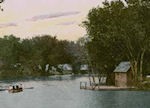 Epworth Park was a large property southwest of Lincoln operated by the Methodist Epworth Association between 1897 and 1940. It was clearly a cultural as well as recreational destination, and featured a man-made lake, amphitheater and restaurants. Visitors could choose to stay at a hotel, cabins, or a campground. Evening programs and Chautauquas featured speakers including Theodore Roosevelt, William Jennings Bryan, and Booker T. Washington.
Epworth Park was a large property southwest of Lincoln operated by the Methodist Epworth Association between 1897 and 1940. It was clearly a cultural as well as recreational destination, and featured a man-made lake, amphitheater and restaurants. Visitors could choose to stay at a hotel, cabins, or a campground. Evening programs and Chautauquas featured speakers including Theodore Roosevelt, William Jennings Bryan, and Booker T. Washington.
Visit Nebraska Memories to search for or browse through many more historical images digitized from photographs, negatives, postcards, maps, lantern slides, books and other materials.
Nebraska Memories is a cooperative project to digitize Nebraska-related historical and cultural heritage materials and make them available to researchers of all ages via the Internet. Nebraska Memories is brought to you by the Nebraska Library Commission. If your institution is interested in participating in Nebraska Memories, see http://nlc.nebraska.gov/nebraskamemories/participation.aspx for more information, or contact Beth Goble, Government Information Services Director, or Devra Dragos, Technology & Access Services Director.
Posted in General, Nebraska Memories
Leave a comment
Looking at the Details
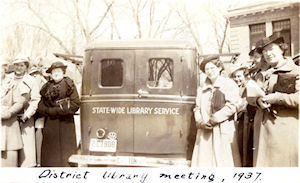 When looking at photos in Nebraska Memories I think it’s important to spend a few minutes looking at the details of a photo. You never know what you may spot. I’ve spotted a few things that made me want to know more. For example go look at this photo of a Group of women standing next to a bookmobile.
When looking at photos in Nebraska Memories I think it’s important to spend a few minutes looking at the details of a photo. You never know what you may spot. I’ve spotted a few things that made me want to know more. For example go look at this photo of a Group of women standing next to a bookmobile.
It’s easy to see that this photo was taken in 1937 at the district library meeting. It looks like all of the women have on coats, hats and gloves. Most of them are holding some type of purse. Did you happen to notice the logo above the license plate? The first time I looked at the details of this photo I was surprised to see the AAA logo on the back of the bookmobile. To be fair I’ve never given the history of AAA much thought but I was surprised to see they were around in 1937. Looking at the AAA website I soon realized I shouldn’t have been surprised. The American Automobile Association was formed in 1902 and introduced services to stranded motorists in 1915. By the time this photo was taken AAA had already been helping stranded motorists for 22 years! I guess I’ll need to start looking at older photos to see if I can find any earlier photos of the logo.
 Here’s another photo for you. This photo of the Wilson Flower Shop is from 1950. Can you spot the logo that I was surprised to see on the door of the delivery truck? Do you recognize FTD Mercury Man? A quick look at the FTD website and I learned that the Florists’ Telegraph Delivery was formed in 1910 and they have been using the Mercury Man logo since 1914.
Here’s another photo for you. This photo of the Wilson Flower Shop is from 1950. Can you spot the logo that I was surprised to see on the door of the delivery truck? Do you recognize FTD Mercury Man? A quick look at the FTD website and I learned that the Florists’ Telegraph Delivery was formed in 1910 and they have been using the Mercury Man logo since 1914.
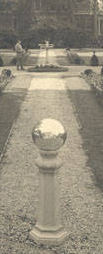 As you can tell I come up with a lot of questions when I start looking at the details in a photo. Did you know gazing balls have been around forever? Saying forever might be going a bit too far but I found multiple sites on the web that say gazing balls date back to Italy in the 13th century. I should note however I’m not sure how reliable these sources are. I can say for sure however that there was a mirrored gazing ball in the garden of the Nye residence in Fremont in 1920-1921. It’s prominently featured in the photo of Ray Julius Nye residence formal gardens.
As you can tell I come up with a lot of questions when I start looking at the details in a photo. Did you know gazing balls have been around forever? Saying forever might be going a bit too far but I found multiple sites on the web that say gazing balls date back to Italy in the 13th century. I should note however I’m not sure how reliable these sources are. I can say for sure however that there was a mirrored gazing ball in the garden of the Nye residence in Fremont in 1920-1921. It’s prominently featured in the photo of Ray Julius Nye residence formal gardens.
Unfortunately for me I can’t easily find satisfying answers. In this photo of the Interior of H. A. Sander Store, Papillion, Nebraska do you see all of the bananas along the left side of the photo? 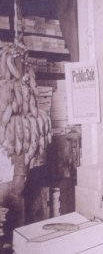 In 1912 how long and how far did the bananas have to travel to reach Papillion? This photo is 100 years old. How much do you think the price of bananas have changed between then and now?
In 1912 how long and how far did the bananas have to travel to reach Papillion? This photo is 100 years old. How much do you think the price of bananas have changed between then and now?
I’m sure it won’t surprise you to read I have more examples of interesting things I’ve found in photos when I take the time to look at the details but I think I’ll save those for another post. Have you spotted any interesting details that make you want to know more? Leave a reply for me and let me know what you’ve found.
Visit Nebraska Memories to search for or browse through many more historical images digitized from photographs, negatives, postcards, maps, lantern slides, books and other materials.
Nebraska Memories is a cooperative project to digitize Nebraska-related historical and cultural heritage materials and make them available to researchers of all ages via the Internet. Nebraska Memories is brought to you by the Nebraska Library Commission. If your institution is interested in participating in Nebraska Memories, see http://nlc.nebraska.gov/nebraskamemories/participation.aspx for more information, or contact Beth Goble, Government Information Services Director, or Devra Dragos, Technology & Access Services Director.
Celebrating Dear Old Dad
The first Father’s Day celebration was held in Spokane, Washington, in 1910. But it wasn’t until forty years ago Father’s Day finally became a permanent national holiday. It took 62 years of promotion and lobbying to overcome resistance to another “commercial” holiday.
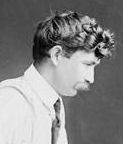 No matter how you celebrate Father’s Day (commercially or otherwise), it can be great fun to look back at images of fathers from the past–or grandfathers, great-grandfathers and fathers of the future. Many images of fathers in Nebraska Memories were taken by Harvey L. Boston, owner of a photography studio in David City, Nebraska, (from 1893 to 1927) including a self-portait with his two young daughters.
No matter how you celebrate Father’s Day (commercially or otherwise), it can be great fun to look back at images of fathers from the past–or grandfathers, great-grandfathers and fathers of the future. Many images of fathers in Nebraska Memories were taken by Harvey L. Boston, owner of a photography studio in David City, Nebraska, (from 1893 to 1927) including a self-portait with his two young daughters.
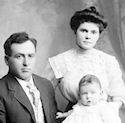
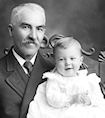 Boston’s photographs include young fathers, such as Fred Keller, at left with his wife, Alice, and their young child. The collection also includes fathers who might have started a second family at an older age, such as William H. McGaffin, at right, who was photographed with his son Wesley, born when his father over 60. McGaffin, a widower who married a second time, had already had 14 children with his first wife.
Boston’s photographs include young fathers, such as Fred Keller, at left with his wife, Alice, and their young child. The collection also includes fathers who might have started a second family at an older age, such as William H. McGaffin, at right, who was photographed with his son Wesley, born when his father over 60. McGaffin, a widower who married a second time, had already had 14 children with his first wife.
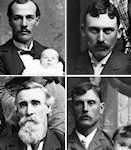
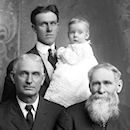
 Other Boston images show multiple generations. The collage to the far left includes members of the Gilbert W. Rogers family; in the photograph two fathers are holding younger children. In the center are four generations of the H. W. Lichliter family. And to the right are four generations of the Harper family: James, Morgan, Jack and Phillip.
Other Boston images show multiple generations. The collage to the far left includes members of the Gilbert W. Rogers family; in the photograph two fathers are holding younger children. In the center are four generations of the H. W. Lichliter family. And to the right are four generations of the Harper family: James, Morgan, Jack and Phillip.

 Some Nebraska Memories images show fathers at work with their children, such as Joe Gatto with his two sons in his store in Lincoln, Nebraska (from the Townsend Studio collection). Others show them relaxing with their families, like the John Birkel family to the right. But, work or play, take some time to celebrate all fathers!
Some Nebraska Memories images show fathers at work with their children, such as Joe Gatto with his two sons in his store in Lincoln, Nebraska (from the Townsend Studio collection). Others show them relaxing with their families, like the John Birkel family to the right. But, work or play, take some time to celebrate all fathers!
Visit Nebraska Memories to search for or browse through many more historical images digitized from photographs, negatives, postcards, maps, lantern slides, books and other materials.
Nebraska Memories is a cooperative project to digitize Nebraska-related historical and cultural heritage materials and make them available to researchers of all ages via the Internet. Nebraska Memories is brought to you by the Nebraska Library Commission. If your institution is interested in participating in Nebraska Memories, see http://nlc.nebraska.gov/nebraskamemories/participation.aspx for more information, or contact Beth Goble, Government Information Services Director, or Devra Dragos, Technology & Access Services Director.
Graduation
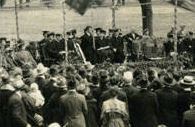 The month of May is just another memory. For some recent graduates the month of May marks an important milestone in their lives. One hundred years ago in 1912 a group of students at Union College were celebrating their graduation as we can see in this photo of their commencement in Nebraska Memories.
The month of May is just another memory. For some recent graduates the month of May marks an important milestone in their lives. One hundred years ago in 1912 a group of students at Union College were celebrating their graduation as we can see in this photo of their commencement in Nebraska Memories.
 There is a small but interesting collection of items relating to graduations in Nebraska Memories. We can see the first graduating class from the Nebraska State Normal School at Kearney from 1906. There is also a picture of four marshals from the 1948 commencement at the Nebraska State Teachers College in Wayne.
There is a small but interesting collection of items relating to graduations in Nebraska Memories. We can see the first graduating class from the Nebraska State Normal School at Kearney from 1906. There is also a picture of four marshals from the 1948 commencement at the Nebraska State Teachers College in Wayne.
The collection also includes a number of programs from commencement exercise. Looking at the program for the 19th annual commencement of the University of Nebraska in Lincoln from June 7, 1888 I was surprised to see two names I recognized. The first name was Frank Henry Woods. Frank Woods and his brothers Mark W. and George J. formed the Woods Brothers Companies in 1889. Today in Lincoln their company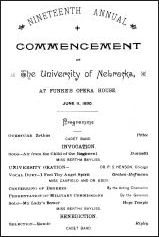 name can still be seen written in stone on the façade of a building on 13th street between N and O. Also when driving around Lincoln you may see the family name in front of a property being sold by the Woods Bros Realty company. Frank Woods is also known for starting the Lincoln Telephone & Telegraph in 1904. The Frank H. Woods Telephone Museum, which is located in Lincoln, bears his name.
name can still be seen written in stone on the façade of a building on 13th street between N and O. Also when driving around Lincoln you may see the family name in front of a property being sold by the Woods Bros Realty company. Frank Woods is also known for starting the Lincoln Telephone & Telegraph in 1904. The Frank H. Woods Telephone Museum, which is located in Lincoln, bears his name.
The other name I recognized in the same commencement program was Roscoe Pound. Pound was a legal scholar and educator. He served as the Dean of the University of Nebraska College of Law and later as the Dean of Harvard Law School. Lincolnites may also recognize the Pound name because of Pound Middle School which was named after the Pound family including Judge Stephen Bosworth Pound, Roscoe, Louise and Olivia Pound.
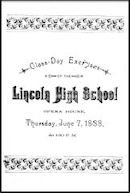 When looking at the 1888 Lincoln High School Class-Day Exercises program I spotted the name Mark Woods. Mark M. Woods was listed as speaking about “Our Nation’s Coast Defenses” while Mark W. was listed as being part of the Class of 1888 and completed the Latin Course. Could this be Frank Woods brother? Unfortunately it’s not a question I was able to answer. Do you know the answer? Leave me a comment if you know!
When looking at the 1888 Lincoln High School Class-Day Exercises program I spotted the name Mark Woods. Mark M. Woods was listed as speaking about “Our Nation’s Coast Defenses” while Mark W. was listed as being part of the Class of 1888 and completed the Latin Course. Could this be Frank Woods brother? Unfortunately it’s not a question I was able to answer. Do you know the answer? Leave me a comment if you know!
Visit Nebraska Memories to search for or browse through many more historical images digitized from photographs, negatives, postcards, maps, lantern slides, books and other materials.
Nebraska Memories is a cooperative project to digitize Nebraska-related historical and cultural heritage materials and make them available to researchers of all ages via the Internet. Nebraska Memories is brought to you by the Nebraska Library Commission. If your institution is interested in participating in Nebraska Memories, see http://nlc.nebraska.gov/nebraskamemories/participation.aspx for more information, or contact Beth Goble, Government Information Services Director, or Devra Dragos, Technology & Access Services Director.
The Season of New Life
Spring is the season of new life. At my house I have baby bunnies munching on my columbines, baby birds sitting on the feeder begging to be fed by their parents , baby dandelions sprouting, and a fresh new crop of mosquitos trying to get their first meal from ME. New arrivals in the human world are not limited to spring, but the abundance of youngsters of all species this month led me to search on the word “baby” in Nebraska Memories to find out what would be revealed. People love babies and love taking their pictures, so it was not a surprise to find nearly 90 images. Many of them are studio portraits.
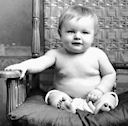 I confess to being guilty of taking a few “nearly naked” baby pictures of my own children, although not at a studio. Young Rudolph Nuttelman of Rising City, clad only in his diaper, is at ease and smiling in this 1906 photo from the Boston Studio Project. I am always amazed by the clarity of scanned images from glass plate negatives and can count each one of his toes. Perhaps a parent was standing behind the photographer doing something silly to make him smile.
I confess to being guilty of taking a few “nearly naked” baby pictures of my own children, although not at a studio. Young Rudolph Nuttelman of Rising City, clad only in his diaper, is at ease and smiling in this 1906 photo from the Boston Studio Project. I am always amazed by the clarity of scanned images from glass plate negatives and can count each one of his toes. Perhaps a parent was standing behind the photographer doing something silly to make him smile.
 This portrait of Agnes Birkel, age 21 months when the photo was taken in 1908, is also from the Boston Studio Project. She and the puppy beside her are an adorable pair. Agnes is looking at someone who is making her smile, but the puppy looks rather sleepy to me. I hope they enjoyed growing up together!
This portrait of Agnes Birkel, age 21 months when the photo was taken in 1908, is also from the Boston Studio Project. She and the puppy beside her are an adorable pair. Agnes is looking at someone who is making her smile, but the puppy looks rather sleepy to me. I hope they enjoyed growing up together!
Babies can be hard to get to sleep, but singing to them helps. Croonings of the Winds is a collection of 12 “slumber songs” in the Polley Music Library collection. This verse from Summer Lullaby by Eudora S. Bumstead really evokes a Nebraska summer evening.
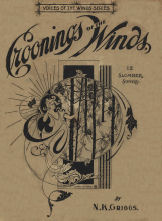 The sun has gone from the shining skies, Bye baby, bye
The sun has gone from the shining skies, Bye baby, bye
The dandelions have closed their eyes, Bye baby, bye
And stars are lighting their lamps to see
If babe and birdy and squir’l all three
Are sound asleep as they ought to be
Bye, baby, bye
Visit Nebraska Memories to search for or browse through many more historical images digitized from photographs, negatives, postcards, maps, lantern slides, books and other materials.
Nebraska Memories is a cooperative project to digitize Nebraska-related historical and cultural heritage materials and make them available to researchers of all ages via the Internet. Nebraska Memories is brought to you by the Nebraska Library Commission. If your institution is interested in participating in Nebraska Memories, see http://nlc.nebraska.gov/nebraskamemories/participation.aspx for more information, or contact Beth Goble, Government Information Services Director, or Devra Dragos, Technology & Access Services Director.
May Day Celebration
Next week is the beginning of May, which includes the celebration of May Day on the first of the month. This holiday is often celebrated in the United States by making May baskets that are usually filled with flowers or treats and left on someone’s doorstep. The giver rings the bell and runs away hoping that the receiver does not catch them and if they are caught a kiss will be exchanged.
In other parts of the world, mainly Western Europe, Maypole dancing is a tradition that signals the end of winter. Participants form a circle around an erected pole to perform the dance. This pole is usually decorated with flags, flowers, garlands, etc., before the event starts. Performers revolve around the pole holding a ribbon, the other end of which is tied to the pole. They first dance in a direction intertwining the ribbon on the pole; later, they perform a similar dance in the reverse direction to unravel the intertwined ribbon.
This image in Nebraska Memories shows students at the Nebraska State Normal School at Kearney (now the University of Nebraska at Kearney) performing a Maypole dance. Maypole dances were held every May from 1912 to 1937; this photograph captures one of the earlier dances.
Many other images of campus life are available as part of the University of Nebraska at Kearney collection.
Visit Nebraska Memories to search for or browse through many more historical images digitized from photographs, negatives, postcards, maps, lantern slides, books and other materials.
Nebraska Memories is a cooperative project to digitize Nebraska-related historical and cultural heritage materials and make them available to researchers of all ages via the Internet. Nebraska Memories is brought to you by the Nebraska Library Commission. If your institution is interested in participating in Nebraska Memories, see http://nlc.nebraska.gov/nebraskamemories/participation.aspx for more information, or contact Beth Goble, Government Information Services Director, or Devra Dragos, Technology & Access Services Director.
Is there a doctor in the house?
 Have you ever needed a ride to the hospital? Or emergency medical care? Consider the medical care available 80-100 years ago. It used to be that ambulances simply transported a person to the hospital (or the morgue). Check out the image of this ambulance used in Lincoln in 1922. (Hodgman ambulance, Townsend Studio collection) You might not get much medical aid on the trip, but there are curtains to close for privacy.
Have you ever needed a ride to the hospital? Or emergency medical care? Consider the medical care available 80-100 years ago. It used to be that ambulances simply transported a person to the hospital (or the morgue). Check out the image of this ambulance used in Lincoln in 1922. (Hodgman ambulance, Townsend Studio collection) You might not get much medical aid on the trip, but there are curtains to close for privacy.
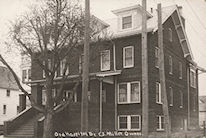 No matter how you reached the hospital all those years ago, you might still have a problem getting into the building. At the Ord Hospital (and others), you had to navigate quite a few stairs to the front entrance. (Ord Hospital, Nebraska State Historical Society collection)
No matter how you reached the hospital all those years ago, you might still have a problem getting into the building. At the Ord Hospital (and others), you had to navigate quite a few stairs to the front entrance. (Ord Hospital, Nebraska State Historical Society collection)
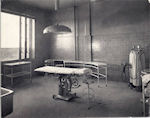 Once inside the hospital, there weren’t many bells and whistles like today. In this image from the Alegent Health Immanuel Medical Center collection, the operating room is plain and simple. A basin for the staff to wash up in, a table that could be raised and lowered, a single light fixture above the table–but hey, there were large windows for extra light, and they opened for fresh air, too.
Once inside the hospital, there weren’t many bells and whistles like today. In this image from the Alegent Health Immanuel Medical Center collection, the operating room is plain and simple. A basin for the staff to wash up in, a table that could be raised and lowered, a single light fixture above the table–but hey, there were large windows for extra light, and they opened for fresh air, too.
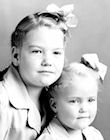
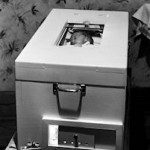 Other mechanical improvements, such as the incubator in the image to the left, may look clunky and out-of-date to us, but you can’t argue with success. The image to the right shows Nancy Lonn, the baby in the incubator, at age four with her older sister Belva Joy. (Thorpe Opera House Foundation/Boston Studio Project collection)
Other mechanical improvements, such as the incubator in the image to the left, may look clunky and out-of-date to us, but you can’t argue with success. The image to the right shows Nancy Lonn, the baby in the incubator, at age four with her older sister Belva Joy. (Thorpe Opera House Foundation/Boston Studio Project collection)
Check out more medical-related images or visit Nebraska Memories to search for or browse through many more historical images digitized from photographs, negatives, postcards, maps, lantern slides, books and other materials.
Nebraska Memories is a cooperative project to digitize Nebraska-related historical and cultural heritage materials and make them available to researchers of all ages via the Internet. Nebraska Memories is brought to you by the Nebraska Library Commission. If your institution is interested in participating in Nebraska Memories, see http://nlc.nebraska.gov/nebraskamemories/participation.aspx for more information, or contact Beth Goble, Government Information Services Director, or Devra Dragos, Technology & Access Services Director.
Posted in General, Information Resources, Nebraska Memories, Technology
1 Comment
Rising Waters
Today is the 100th anniversary of the March 30th, 1912 flood in Valley Nebraska. This year we are experiencing one of the warmest and driest months of March on record and drought is more to be feared than flooding. But last year was a different story – mountain snowpack and torrents of rain in Montana caused the Missouri River to flood. The Valley flood a century ago is another reminder that March is indeed a lion and a lamb. The winter of 1912 must have been much colder and longer than the one we have just experienced, because the large amount of ice still on the rivers formed ice jams and caused a very destructive flood.
Valley is located between the Platte and the Elkhorn rivers. The confluence of the two rivers is several miles south of the town. This excerpt from the Norfolk weekly News-Journal, March 29, 1912, Page 8 describes conditions at Valley on Tuesday, March 26.
“A. T. Hutchinson of the A. L. Kulian Co. , returned last night from Valley , Neb. , where he attended a directors meeting of a seed house of which he is a director. Mr. Hutchinson reports that much fear is entertained at Valley and Waterloo over the flood stage of the Platte river which is thirty feet high at the narrowed channel at the Burlington bridge at Fremont. The ice is thirty-six inches thick and a gorge is forming. Blasting has been going on for a week , but it is not believed that this will save the lowlands arount Valley from a flood. The Elkhorn river, says Mr. Hutchinson, is in good shape and he can see no danger of a flood in this vicinity.”
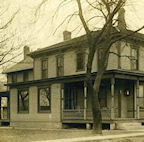 Valley Public Library has contributed a collection of photographs to Nebraska Memories depicting the town both before and after the flood. This 1910 photo of Reid’s Hotel at the corner of Front and Pine streets shows a substantial two-story building flanked by trees and paved sidewalks.
Valley Public Library has contributed a collection of photographs to Nebraska Memories depicting the town both before and after the flood. This 1910 photo of Reid’s Hotel at the corner of Front and Pine streets shows a substantial two-story building flanked by trees and paved sidewalks.
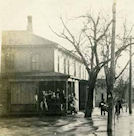 Two years later, this March 30, 1912 photo of the same corner shows that the flooding may have been even worse than Mr. Hutchinson’s comments to the newspaper suggested. Water is lapping at the foot of the front porch of the hotel and several people are standing on it surveying the flooded street. There must have been a lot of damage to the ground floor of the hotel and all the buildings on those streets. The photo description indicates that flood waters from the Platte and Elkhorn rivers merged and some areas were covered in four feet of muddy water.
Two years later, this March 30, 1912 photo of the same corner shows that the flooding may have been even worse than Mr. Hutchinson’s comments to the newspaper suggested. Water is lapping at the foot of the front porch of the hotel and several people are standing on it surveying the flooded street. There must have been a lot of damage to the ground floor of the hotel and all the buildings on those streets. The photo description indicates that flood waters from the Platte and Elkhorn rivers merged and some areas were covered in four feet of muddy water.
This photo taken in April 1912 shows damage to a wagon road near the railroad tracks. The road has eroded away and looks like a “gorge” such as Mr. Hutch inson told about. As the flood waters recede, undermined utility poles are falling over. The pole with the repair man perched on it looks like it could topple into the water at any moment–not a place I would have wanted to be! According to the photo description damages to the area were estimated at $40,000 – a hefty sum a century ago.
inson told about. As the flood waters recede, undermined utility poles are falling over. The pole with the repair man perched on it looks like it could topple into the water at any moment–not a place I would have wanted to be! According to the photo description damages to the area were estimated at $40,000 – a hefty sum a century ago.
And how would you like to be the poor people living in these homes? More photographs of the Valley flood of 1912 can be viewed in Nebraska Memories.
Visit Nebraska Memories to search for or browse through many more historical images digitized from photographs, negatives, postcards, maps, lantern slides, books and other materials.
Nebraska Memories is a cooperative project to digitize Nebraska-related historical and cultural heritage materials and make them available to researchers of all ages via the Internet. NebraskaMemories is brought to you by the Nebraska Library Commission. If your institution is interested in participating in Nebraska Memories, see http://nlc.nebraska.gov/nebraskamemories/participation.aspx for more information, or contact Beth Goble, Government Information Services Director, or Devra Dragos, Technology & Access Services Director.
The Faces of 1940
 As many of you may know 1940 is an important year to genealogists and historians right now. On April 2, 2012 at 9 AM EDT the U.S. National Archives and Records Administration will make the 1940 Census available to the public online. This is the first time the 1940 Census can be made available because of the 72-year rule. This rule basically states that the U.S. government cannot release personally identifiable information about a person until 72 years after it’s been collected.
As many of you may know 1940 is an important year to genealogists and historians right now. On April 2, 2012 at 9 AM EDT the U.S. National Archives and Records Administration will make the 1940 Census available to the public online. This is the first time the 1940 Census can be made available because of the 72-year rule. This rule basically states that the U.S. government cannot release personally identifiable information about a person until 72 years after it’s been collected.
 As some of us anxiously wait for April 2 I thought it would be fun to look at the faces of people from 1940 as documented in Nebraska Memories. To start
As some of us anxiously wait for April 2 I thought it would be fun to look at the faces of people from 1940 as documented in Nebraska Memories. To start ![]() off the year it appears they had more snow in the early months of 1940 then we did this year. A photo from January 1940 shows a large group of children bundled in their winter coats sitting and in the back of a pickup truck on a snow covered road. Another photo from February shows a boy outside in his coat and hat shoveling snow.
off the year it appears they had more snow in the early months of 1940 then we did this year. A photo from January 1940 shows a large group of children bundled in their winter coats sitting and in the back of a pickup truck on a snow covered road. Another photo from February shows a boy outside in his coat and hat shoveling snow.
 Photos taken in March of 1940 give us a glimpse of the workers at the Falstaff Brewery. The brewery was located at 25th and Vinton in Omaha. In contrast to the brewery works dressed in overalls most of the business men of Bertrand and
Photos taken in March of 1940 give us a glimpse of the workers at the Falstaff Brewery. The brewery was located at 25th and Vinton in Omaha. In contrast to the brewery works dressed in overalls most of the business men of Bertrand and  Loomis are pictured wearing ties with jackets or vests. According to the note this group of businessmen was on an outing to the Central Nebraska Public Power and Irrigation District.
Loomis are pictured wearing ties with jackets or vests. According to the note this group of businessmen was on an outing to the Central Nebraska Public Power and Irrigation District.  The 10th grade class of Bruno High School got their picture taken on April 30, 1940. The four young men in the class look dashing in their dark suites.
The 10th grade class of Bruno High School got their picture taken on April 30, 1940. The four young men in the class look dashing in their dark suites.
 The latter half of 1940 appeared to be the time for fun just by looking at the photos in Nebraska Memories. I have no idea who George Turner was but it sure looks like he knew how to through a party. One photo from the party shows a number of party goers proudly holding up their mugs of beer. I have to wonder if it’s Falstaff beer. The party goers even had a mock shotgun wedding at the party.
The latter half of 1940 appeared to be the time for fun just by looking at the photos in Nebraska Memories. I have no idea who George Turner was but it sure looks like he knew how to through a party. One photo from the party shows a number of party goers proudly holding up their mugs of beer. I have to wonder if it’s Falstaff beer. The party goers even had a mock shotgun wedding at the party.
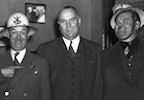 The other fun event documented was Laurel and Hardy appearing in person at the Orpheum Theatre in October of 1940. I bet that would have been a fun show to attend.
The other fun event documented was Laurel and Hardy appearing in person at the Orpheum Theatre in October of 1940. I bet that would have been a fun show to attend.
 I hope you enjoyed looking at some of the faces of 1940 as you wait to view the 1940 Census. You can learn more about the 1940 Census by visiting the National Archives 1940 Census website. If you’ve never explored a historic U.S. Census Nebraskan’s have access to the 1790-1930 Census through the HeritageQuest Online databases. This database is made available at no cost to all Nebraskans through NebraskAccess.
I hope you enjoyed looking at some of the faces of 1940 as you wait to view the 1940 Census. You can learn more about the 1940 Census by visiting the National Archives 1940 Census website. If you’ve never explored a historic U.S. Census Nebraskan’s have access to the 1790-1930 Census through the HeritageQuest Online databases. This database is made available at no cost to all Nebraskans through NebraskAccess.
Visit Nebraska Memories to search for or browse through many more historical images digitized from photographs, negatives, postcards, maps, lantern slides, books and other materials.
Nebraska Memories is a cooperative project to digitize Nebraska-related historical and cultural heritage materials and make them available to researchers of all ages via the Internet. Nebraska Memories is brought to you by the Nebraska Library Commission. If your institution is interested in participating in Nebraska Memories, see http://nlc.nebraska.gov/nebraskamemories/participation.aspx for more information, or contact Beth Goble, Government Information Services Director, or Devra Dragos, Technology & Access Services Director.
Memories is brought to you by the Nebraska Library Commission. If your institution is interested in participating in Nebraska Memories, see http://nlc.nebraska.gov/nebraskamemories/participation.aspx for more information, or contact Beth Goble, Government Information Services Director, or Devra Dragos, Technology & Access Services Director.
